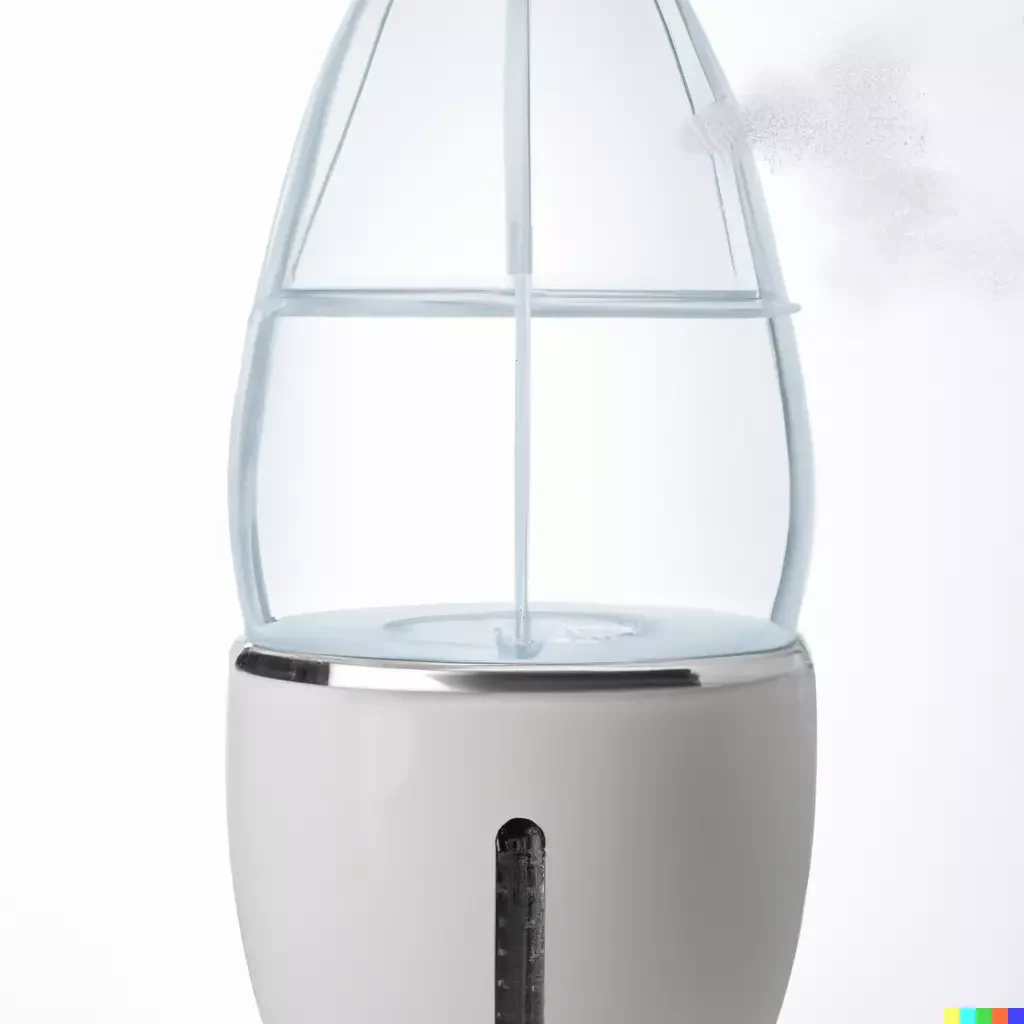Pink Stuff in Humidifier? Learn how to solve pink buildup in humidifiers with our easy tips. Keep your humidifier clean and running smoothly with our expert advice.
Humidifiers are a great way to add moisture to the air, especially during the dry winter months. However, if you’ve noticed pink buildup in your humidifier, you may be wondering what it is and how to get rid of it.
The pink buildup is caused by a type of bacteria called Legionella pneumophila, which can thrive in warm, damp environments.
In this blog post, we’ll explain what causes pink buildup in humidifiers and provide some easy solutions for getting rid of it and preventing it from happening again.
We’ll also discuss the importance of keeping your humidifier clean and properly maintained to ensure the unit is safe to use.
So, if you’re tired of dealing with pink buildup in your humidifier, keep reading to learn more!
Pink Residue in Humidifier

Pink residue in a humidifier can be caused by the growth of a type of bacteria or mold commonly found in warm, damp environments. This type of mold is often pink or reddish in color and is known as “pink mold” or “pink slime.”
The presence of pink residue in a humidifier can indicate that the device is not being cleaned and maintained properly, and can also be a sign that the water in the humidifier is not being changed frequently enough.
To prevent the growth of pink mold in a humidifier, it is important to clean the device regularly and to use clean, fresh water.
You should also empty and clean the water tank and clean the humidifier’s filter or wick as per the manufacturer’s instructions.
It is also recommended to keep the humidifier’s environment clean and dry as much as possible and to use a humidifier with a built-in UV light to kill off any bacteria or mold.
What is Pink Mold?
Pink mold, also known as pink slime or pink bacteria, is a type of mold or bacteria that can grow in damp or humid environments, such as bathrooms, kitchens, and basements.
It can appear as a pink or reddish-brown discoloration on surfaces such as tile, grout, and caulk. Pink mold is not typically harmful to healthy individuals, but it can cause allergic reactions or respiratory problems in people with weakened immune systems.
It is important to clean and remove any pink mold from your home, to prevent it from spreading and to maintain a clean and healthy environment.
Can Pink Mold in Humidifier Make You Sick?
Pink mold, or any mold for that matter, growing in a humidifier can potentially make people sick, especially those with weakened immune systems, allergies, or respiratory issues.
When a humidifier is not properly cleaned and maintained, mold and bacteria can grow in the water tank and be dispersed into the air through the humidifier’s mist.
This can cause respiratory problems, such as coughing, sneezing, and difficulty breathing, as well as allergies and other symptoms.
Inhaling mold spores can also cause more serious health problems, such as infections in the lungs, asthma, and hypersensitivity pneumonitis, a type of lung inflammation.
People with a weakened immune system, such as those with HIV, cancer, or diabetes, may be at a higher risk of getting sick from mold exposure.
It is important to clean and maintain your humidifier properly by following the manufacturer’s instructions and changing the water frequently to prevent mold and bacteria growth.
Additionally, If you notice any symptoms or if you are already suffering from respiratory issues, it is better to consult with a doctor.
What Causes Pink Mold?
Pink mold, also known as pink bacteria or pink slime, is caused by the growth of certain types of bacteria or mold in damp or humid environments.
These microorganisms thrive in warm, moist conditions and can grow on various surfaces such as tile, grout, caulk, and other materials found in bathrooms, kitchens, basements, and other damp areas.
Factors that can contribute to the growth of pink mold include:
High humidity:
Humidity levels above 60% can create an ideal environment for mold growth.
Lack of ventilation:
Poor ventilation can trap moisture and increase the humidity level, providing a suitable environment for mold to grow.
Leaks:
Leaks or water damage can provide a source of moisture for mold to grow.
Dirty surfaces:
Dirty surfaces that have not been cleaned or disinfected can provide a source of food for mold to grow.
Poor maintenance:
Not cleaning and maintaining areas properly, such as not cleaning humidifiers or not changing the water frequently, can also contribute to mold growth.
By identifying and addressing the cause of mold growth, it can be prevented and controlled. It is important to keep the environment dry and clean, to ventilate well, and to address any water leaks or damage.
Additionally, regular cleaning and disinfecting of surfaces can prevent mold from growing and spreading.
What Color Mold Is Toxic?
All types of mold can be potentially harmful to human health, regardless of their color. The type of mold and the degree of exposure are the determining factors for toxicity.
Some molds release toxins called mycotoxins, which can cause health problems when inhaled, ingested, or come in contact with the skin.
Some common toxic molds include:
- Black mold (Stachybotrys chartarum) can produce mycotoxins that can cause serious health problems, particularly in people with compromised immune systems, respiratory issues, or allergies.
- Aspergillus can cause lung infections, allergies, and other health problems.
- Penicillium can produce mycotoxins that can cause allergic reactions and respiratory issues.
It’s important to note that not all strains of the above-mentioned molds are toxic, but they can cause health problems if they are not handled or removed properly.
Mold exposure can cause symptoms such as sneezing, coughing, runny nose, red eyes, irritation of the skin or throat, and in some cases, severe respiratory problems.
If you suspect that there is mold in your home, it’s important to have it inspected and removed by a professional.
How Do You Know if You Have Mold Poisoning?
Mold poisoning, also known as mold toxicity or toxic mold exposure, is caused by inhaling or ingesting mold spores.
Symptoms of mold poisoning can vary depending on the type of mold and the length of exposure, but some common symptoms include the following:
- Allergic reactions, such as sneezing, runny nose, red eyes, and skin rash
- Respiratory symptoms, such as wheezing, difficulty breathing, and chest tightness
- Headaches and migraines
- Fatigue and weakness
- Nausea and vomiting
- Memory problems and difficulty concentrating
- Depression and anxiety
If you suspect that you have mold poisoning, it is important to see a medical professional for an evaluation. Your doctor may order laboratory tests, such as a blood test, to check for mold exposure.
They may also refer you to an allergist or immunologist for further evaluation and treatment.
It’s important to note that not all mold exposure leads to mold toxicity and symptoms, and not everyone exposed to mold will develop symptoms. If you have any concerns, it’s best to consult your doctor.
How Do Get Rid Of Pink Stuff In Humidifier?
Pink mold, also known as Serratia marcescens, can grow in humidifiers and other areas with high humidity levels. To get rid of pink mold in your humidifier, you can follow these steps:
- Unplug the humidifier and empty any remaining water.
- Clean the humidifier thoroughly with warm, soapy water. Use a brush or cloth to scrub away any visible mold.
- Rinse the humidifier thoroughly with clean water to remove any remaining soap and mold.
- Disinfect the humidifier by adding a solution of 1 part white vinegar to 3 parts water or a solution of 1 teaspoon of bleach to 1 gallon of water. Run the solution through the humidifier for at least 30 minutes.
- Rinse the humidifier thoroughly with clean water to remove any remaining vinegar or bleach solution.
- Allow the humidifier to dry completely before using it again.
- Clean the humidifier regularly to prevent mold from growing again.
It’s important to note that mold can grow in humidifiers when the water is not changed frequently or if the humidifier is not cleaned regularly.
So, it’s important to change the water in the humidifier and clean it as per the manufacturer’s instructions.
If the problem persists after following these steps, consider replacing the humidifier, especially if it’s an old unit.
It’s also important to maintain good indoor air quality by keeping your home well-ventilated, using air purifiers and dehumidifiers, and keeping the humidity levels in your home at a healthy level (between 30-50%)





